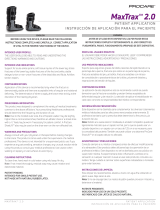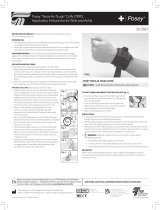McKESSON Walker Boot Non Air Guía del usuario
- Tipo
- Guía del usuario

Walker Boot Non-Air
For use with MFR #’s 155-79-95502, 155-79-95503, 155-79-95505, 155-79-95507,
155-79-95508, 155-79-95492, 155-79-95493, 155-79-95495, 155-79-95497, 155-79-95498
BEFORE USING THE DEVICE, PLEASE READ THE FOLLOWING INSTRUCTIONS
COMPLETELY AND CAREFULLY. CORRECT APPLICATION IS VITAL TO THE
PROPER FUNCTIONING OF THE DEVICE.
INDICATIONS
Acute ankle sprains, soft tissue injuries of the lower leg, stress fractures of the lower leg
and ankle, stable fractures of the foot and ankle, stable delayed union or non-union
fractures of the distal tibia and fibula, and Achilles tendon repairs.
CONTRAINDICATIONS
Application of this device is recommended only when the fracture is demonstrably stable
and there are acceptable limits of angular and rotational deformity. The determination
of when to apply the brace rests strictly at the discretion of the treating physician.
PRECAUTIONS
• If you experience any pain, swelling, sensation changes, or any unusual reactions while using this
product, consult your medical professional immediately. Like all lower extremity immobilizers,
such as casts or braces, patients without sensation (ie: post-op anesthesia, neuropathies, etc.)
should be monitored frequently for “hot spots,” skin irritation or wound management.
• Use caution when walking on slippery or wet surfaces to avoid injury. Always consult
with your physician or therapist before making changes to the brace. This product is to be used
under the supervision of a medical professional. This device is not intended for unsupervised
public use.
• Always inspect before use. Check for broken stitches or parts; torn, cut or frayed material; or
buckles, or hook and loop fasteners that do not hold securely. Do not use damaged product.
Discontinue use when torn, worn, or frayed in any way.
• Never alter or repair this product. This product is not intended to be used with any other product
except approved accessories. Use a sneaker or street shoe on uninjured foot while ambulating to
compensate for leg length changes while wearing a fracture walking brace.
DIRECTIONS FOR USE
1. Unfasten straps and remove liner from boot.
2. Place foot in liner with the heel fitting snugly into the back portion of the liner. Fasten and wrap
foot flaps then the leg portion of the liner. Liner should be snug from top to bottom but should
not constrict.
3. With the colored “pull up” tabs intact, gently spread the side struts and place the foot onto the
foot plate heel first, then the forefoot. The ankle should be centered at the struts with the foot
and ankle at 90°.
4. Once in the correct alignment, remove the colored “pull up” tabs and gently push the struts
towards the liner to ensure the hook and loop on the walking brace is making contact with
the liner.
5. Fasten the hook and loop straps beginning at the toe then moving up the limb. Do not over
tighten. As swelling patterns change it may be necessary to adjust the straps.
6. To remove, simply unfasten the straps without removing them completely from the assembled
walker. Unfasten the soft good liner and gently bring the foot and ankle forward and out of the
walker. To reapply, place the foot and ankle into the liner and reattach the Velcro closures .
NOTE: For added comfort, the extra rectangular shaped pads may be used for extra padding
inside the liner, under the straps, between the walking brace shell and the liner, etc.
CLEANING INSTRUCTIONS
Hand wash liners using mild soap, rinse thoroughly. AIR DRY. NOTE: If not rinsed
thoroughly, residual soap may cause irritation and deteriorate material.
FOR SINGLE PATIENT USE ONLY.
Not made with natural rubber latex.
Questions? Call 1-800-777-4908
Technical Support? Call 1-800-336-6569
Distributed by McKesson Medical-Surgical Inc.
Richmond, VA 23233
PVN A0520
PN 13-5534 Rev A
Made in Vietnam
Symbol Definitions
Symbol Definition
Consult instructions for use
Caution, consult accompanying documents
NOTICE: While every effort has been made in state-of-the-art techniques to obtain the maximum
compatibility of function, strength, durability and comfort, this device is only one element in the
overall treatment program administered by a medical professional. There is no guarantee that
injury will be prevented through the use of this product.
Bota de Andador sin Aire
For use with MFR #’s 155-79-95502, 155-79-95503, 155-79-95505, 155-79-95507, 155-79-95508,
155-79-95492, 155-79-95493, 155-79-95495, 155-79-95497, 155-79-95498
ANTES DE UTILIZAR ESTE DISPOSITIVO, LEA POR FAVOR ESTAS INSTRUCCIONES
COMPLETA Y DETENIDAMENTE. EL USO CORRECTO ES FUNDAMENTAL PARA EL
FUNCIONAMIENTO APROPIADO DE ESTE DISPOSITIVO.
INDICACIONES
Esguinces graves de tobillo, lesiones de tejido blando en la parte baja de la pierna, fracturas por
fatiga en la parte baja de la pierna y el tobillo, fracturas estables del pie y el tobillo, fracturas
estables con retraso de consolidación o pseudoartrósicas de la tibia y el peroné distales y
reparaciones del tendón de Aquiles.
CONTRAINDICACIONES
La aplicación de este dispositivo solo se recomienda cuando se pueda demostrar que la fractura es
estable y existan límites aceptables de deformidad angular y de rotación. La decisión de aplicar el
estabilizador en cada caso concreto es responsabilidad del médico correspondiente.
PRECAUCIONES
• Si experimentara dolor, inflamación, cambios en la sensación o cualquier reacción inusual al
usar este producto, consulte a su médico inmediatamente. Al igual que sucede con las escayolas,
abrazaderas y demás inmovilizadores de las extremidades inferiores, los pacientes sin
sensibilidad (anestesia postoperatoria, neuropatías, etc.) deben supervisarse a menudo para
detectar posibles puntos delicados, irritación de la piel o heridas.
• Para evitar accidentes, sea precavido si ha de caminar por superficies resbaladizas o húmedas.
Consulte siempre a su médico o terapeuta antes de efectuar modificaciones a la abrazadera.
Este producto debe utilizarse bajo supervisión de un profesional médico. Este dispositivo no
se ha disenado para uso público sin supervisión médica.
• Inspeccione el producto antes de cada uso. Compruebe si existen roturas en los cosidos o piezas
rotas, material rasgado, cortado o desgastado; compruebe también si existen hebillas o cierres
de gancho y lazo que no queden bien fijados. No utilice el producto si está danado. Interrumpa el
uso si está desgarrado, desgastado o deshilachado de forma alguna.
• Nunca altere ni repare el producto. Este producto no está disenado para su uso con ningún otro
producto excepto los accesorios aprobados. Utilice una zapatilla de deporte o una zapatilla
urbana en el pie sin lesiones mientras camina para compensar los cambios de longitud de la
pierna mientras lleva puesto una ortesis de fractura.
LAS INSTRUCCIONES DE USO
1. Abra las cintas y extraiga el forro de la bota.
2. Coloque el pie en el forro haciendo que el talón quede cómodamente ajustado en la parte
posterior del forro. Cierre las solapas de los pies y, después la parte de la pierna. El forro debe
quedar ajustado de arriba a abajo, pero no debe apretar.
3. Con las lengüetas para tirar coloreadas intactas, despliegue cuidadosamente los soportes
laterales y coloque el pie en la placa para el pie; el talón en primer lugar y, después, el resto del
pie. El tobillo debe quedar centrado entre los soportes con el pie y el tobillo formando un ángulo
de 90°.
4. Una vez realizada correctamente la alineación, retire las lengüetas para tirar coloreadas y
empuje suavemente los soportes hacia el forro para asegurarse de que el sistema de
enganche y lazo del inmovilizador para caminar hace contacto con el forro.
5. Fije las cintas de del sistema de enganche y lazo empezando por la punta del pie y siguiendo
por la pierna. No la apriete demasiado. A medida que cambien los patrones de inflamación
podría ser necesario volver a ajustar las cintas.
6. Para retirarlo, simplemente desabroche las correas sin extraerlas totalmente del andador
ensamblado. Desabroche el forro acolchado y mueva lentamente el pie y el tobillo hacia adelante
hasta que estén fuera del andador. Para volver a colocarlo, ponga el pie y el tobillo en el forro, y
abroche de nuevo los cierres de Velcro. NOTE: Para obtener mayor comodidad, se pueden utilizar
las almohadillas rectangulares adicionales para colocarlas dentro del forro, bajo las cintas, entre
la capa del inmovilizador para caminar y el forro, etc.
INSTRUCCIONES DE LIMPIEZA
Lave a mano los forros con jabón suave y enjuáguelos bien. SÉQUELOS AL AIRE. Nota: Si no se
enjuaga correctamente, los restos de jabón pueden ocasionar irritación y deteriorar el material.
PARA USO EN UN SOLO PACIENTE.
No está hecho con látex de caucho natural.
Distribuido por McKesson Medical-Surgical Inc.
Richmond, VA 23233
PVN A0520
PN 13-5534 Rev A
Hecho en Vietnam
AVISO: Si bien se han hecho todos los esfuerzos posibles con las técnicas más modernas para
obtener la compatibilidad máxima de la función, resistencia, durabilidad y comodidad, no existe
garantía alguna de que se evitarán lesiones durante el empleo de este producto.
Definiciones de Símbolos
Símbolo Definición
Consulte las instrucciones de uso
Precaución: consultar los documentos adjuntos
By Brian Wenzel at 11:27 am, May 22, 2020
By Angel Wolfe at 3:50 pm, May 22, 2020
-
 1
1
McKESSON Walker Boot Non Air Guía del usuario
- Tipo
- Guía del usuario
en otros idiomas
Otros documentos
-
 Procare MaxTrax Instrucciones de operación
Procare MaxTrax Instrucciones de operación
-
Fabrication Enterprises 24-2936 Manual de usuario
-
Ottobock 6Y200 Manual de usuario
-
DJO AIRCAST Guía del usuario
-
Orliman EST-083 Instrucciones de operación
-
Otto Bock 1C66 Triton Instructions For Use Manual
-
Teeter Contour Power* El manual del propietario
-
 Posey 2789Q Instrucciones de operación
Posey 2789Q Instrucciones de operación
-
Klein Tools CN1972ARL Manual de usuario


